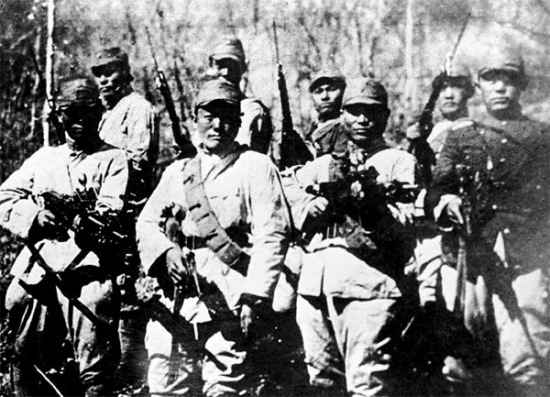
The Northeast Anti-Japanese United Army, a communist-led guerrilla force, offered the largest resistance to Japan's occupation of northeastern China and the Manchukuo puppet regime it established in the area. (Photo/Provided to China Daily)
During the Japanese occupation of Manchuria and also during World War II, a small, Communist-led guerrilla force was at the forefront of resistance in Northeast China. Now, that contribution is set to win the respect it deserves.
Cao Baoming is desperate to record as many stories as possible about events in the Changbai Mountains more than 70 years ago, when the 1,300-kilometer-long range was the main theater of resistance to the Japanese occupation of China.
No one knows exactly how many Chinese soldiers died in the fierce fighting that encompassed the mountains that separate China, Russia and the Democratic People's Republic of Korea, but Cao is determined to discover as much as he can.
"So little has been recorded about NAJUA," said the vice-president of the Jilin Provincial Folk Literature and Art Society.
Cao was referring to the Northeast Anti-Japanese United Army, a communist-led guerrilla force that offered the largest resistance to Japan's occupation of northeastern China and the Manchukuo puppet regime it had established.
"Japan used northeast China as the supply base for its more-distant military excursions. Without the constant attacks by NAJUA that diverted its attention and strength, the Japanese army would have found it easier to turn its aggression on the rest of China," he said.
"The Japanese had worked out many ways to cut NAJUA's supply lines, but the guerrillas persevered and launched attacks that forced the Japanese to divert forces for punitive expeditions against them," he added.
However, to Cao's dismay, very few files and documents relate to this important part of Chinese history. "Apart from the stories of Yang Jingyu and several other NAJUA leaders, people rarely know the history, let alone the stories of those unknown soldiers," he said.
Cao spent the last Lunar New Year holiday at a private nursing home for old soldiers, and during his visit, he met a NAJUA veteran.
"I was absolutely moved by his stories, which were so real and new to me," he said. "Oral history is one of the few ways we can learn about this guerrilla army. The surviving NAJUA veterans are part of a history that should be remembered."
Recording history
At the end of March, the 66-year-old set up a project to record the veterans' stories, hoping to glean more information about NAJUA.
He was overjoyed when the Jilin Civil Affairs Department released the names of 271 veterans, but his mood darkened as more details came to light.
Between March and the end of April, 27 of the veterans died, and of the others more than half were in very poor health, paralyzed and unable to speak. A further 10 percent had moved to unknown locations.
"It's very worrying that so few of them have comparatively clear minds and can recall details accurately. It's a race against time because the youngest is 87 and the oldest is 98," Cao said.
More than 30 volunteers traveled far and wide to visit veterans and record their stories. So far, the stories of 50 veterans have been detailed.
"I'm really grateful to the volunteers, because they did the work in their own time and paid the expenses out of their own pockets," Cao said.
According to Wen Ye, historian and former curator of the NAJUA Museum in Harbin, capital of Heilongjiang province, the Japanese regarded the guerrillas as a cancer that greatly undermined their administration and derailed their military plans: "The important role NAJUA played in China's war against fascism made Manchukuo, the Japanese base, very unstable."
Wen said NAJUA's history can be divided into three phases: the Northeast anti-Japanese guerrillas: the Northeastern People's Revolutionary Army; and NAJUA.
Records at the Museum of Japanese Aggression in Changchun show that in 1934 all Communist Party units in the region were reorganized into a single force - the Northeast Anti-Japanese United Army, under the leadership of Zhao Shangzhi, an energetic graduate of the Whampoa Military Academy.
The following year, the guerrilla army was opened to anyone willing to fight, a move that won the support of students, farmers and even some local bandits.
By NAJUA's 1937 heyday, troop numbers had swollen to more than 30,000, and its sphere of action encompassed more than 70 counties across Northeast China.
Earlier this year, Cao traveled to Baishan in Jilin to visit Huang Dianjun, a veteran who had been close to Yang Jingyu, a NAJUA commander.
















































